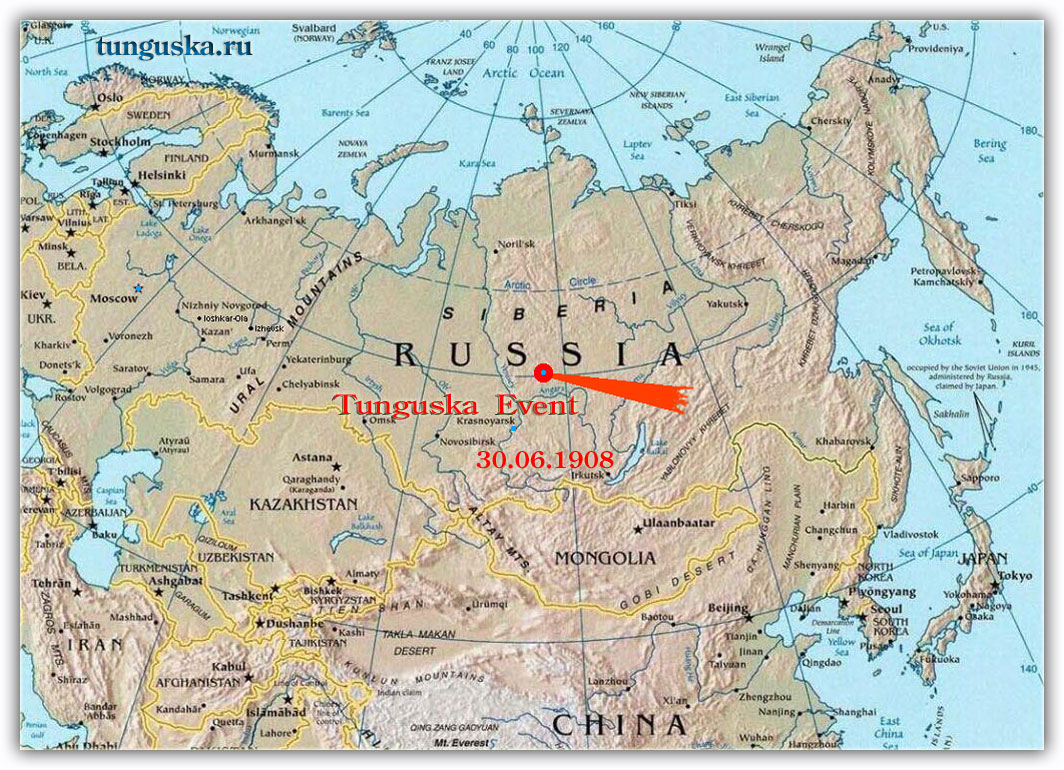
Talk about an explosive off-season! With all of the trades going on leading into the draft, it’s been hard to keep track of things sometimes. While everyone’s most notably fixated on the Rams right now, I have to say, I was more intrigued by Jason Pierre-Paul headed to Tampa Bay. I had hoped to add him in to my defensive line, but ultimately, the price just wasn’t quite right. All the same, I had a chat about things with the league’s leading pyrotechnics expert. He said that with his newfound knowledge (and a recently developed disdain for hands-on learning), he’s been enjoying reading about the subject of explosions a lot more than observing them firsthand. At any rate, when JPP told me the story about this week’s Weird Mystery, I of course was immediately compelled to hop in the van and go investigate…
THE TUNGUSKA EVENT
Location: Podkamenaya Tunguska, Siberia, Russia

The Story: In the early morning of a clear summer’s day in rural Siberia, near the area of Podkamenaya Tunguska, a massive explosion of some variety levelled over 2,000 square kilometers (800 square miles) of wilderness. While the forest was ripped to shreds thanks to the impact of the blast, curiously enough, there was very little impact to the human population of the area; there were only two unconfirmed deaths as a result of the blast, which still remain unconfirmed to this day. The impact of this explosion has been estimated as a 5.0 on the Richter scale – an extremely high level for something not caused by shifting plate tectonics. For other additional impressive measurements, consider the following: the blast has been estimated as equivalent to somewhere between 15-30 megatons of TNT – over 1,000 times as powerful as the atomic bomb dropped on Hiroshima. (Unrelated: the Soviet Union’s Tsar Bomba, detonated in 1961, was estimated at 50 megatons, and is the single largest weapon ever detonated in the history of the world – it’s absolute insanity that it could somehow be more powerful than this, and yet…)

The other strange thing about this explosion was that glowing skies were observed across Europe and central Asia for days afterwards; while dust particles have been known to cause unusual sights in the sky due to refracted light from various substances present in the atmosphere shortly thereafter, it is curious that it would have been observable from such a distance so soon after the initial blast. For comparison, the impacts on the atmosphere from the Krakatoa volcanic eruption in the 1880s were not immediately noticeable on a global basis until several weeks afterwards.

There are a number of scientists who believe the explosion was due to a burst of air from a meteor or comet entering the atmosphere; however, this theory, while still the most plausible of all possible explanations, is still not universally agreed upon due to the fact that there was no impact crater left at the site of the explosion, similar to what has been observed in other meteor impacts such as the Chicxulub crater in Mexico’s Yucatan peninsula which is believed to have wiped out the dinosaurs. Some researchers believe that the object may not have been a meteor that caused the explosion, but rather a comet; unlike a meteor, which is solid rock, a comet is comprised predominantly of ice and various dust matter. Due to the intense heat of the friction caused by Earth’s atmosphere, it is thus logical that most of the evidence of a comet would have been melted away very quickly afterwards. Meteor or comet, though, many scientists theorize that the object was mostly vaporized while still in the atmosphere – which would explain the lack of an impact crater on the ground.
A German astrophysicist by the name of Wolfgang Kundt is the most notable dissenter on the Tunguska Event; he has theorized that the explosion was actually not extraterrestrial in cause at all, but rather by a leak of 10 million tons of natural gas from the Earth’s core. The slow leak, which when lit by a natural cause such as lightning, would have caused the entire cloud of gas to erupt and cause the widespread damage observable in photos.
Coach Carroll’s Hypothesis: WE ARE GETTING FUCKING NUKED BY MARS, MEN. It takes a while for these things to reach Earth, you know. That blast in Chelyabinsk from 2013? THERE’S A REASON THE MEDIA DOESN’T WANT TO TALK ABOUT THIS KIND OF STUFF. It’s times like these where I’m pretty jealous that Hendrix, Joplin, Hoffa and the gang are all safely inside the Earth, safe from the impact from space…
Information from this article taken from here, here, here and here.
Banner image courtesy of Low Commander of the Super Soldiers.
The crazy thing about Tsar Bomba is that they used a lead tamper (basically a second stage) instead of U-238 to limit the amount of fallout. If they had done so the theoretical yield would have been around 100 MT.
Obligatory…

Are we sure it wasn’t from Tom Cable lighting a fart?
i would have gone with Andy Reid, but it’s got to be this
Hendrix and Joplin are buried in the Giants end zone?!?
“…”
– Sparano’s football